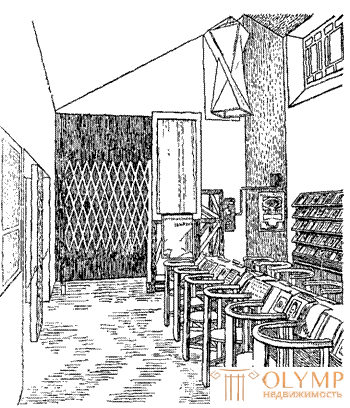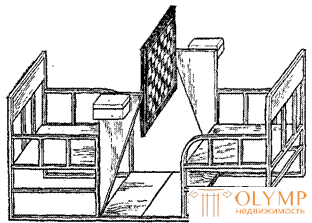
The development of furniture in Soviet art has passed a long and difficult path. However, the creation of furniture has always been subordinated to the requirement of solving social problems and the desire to give the Soviet people the most comfortable products that meet the high aesthetic requirements.
In the first years after the revolution, architecture was characterized by a desire for grandiose compositions, arising from an elevated perception of life. This was most vividly reflected in the draft of the monument to the III International (1919, V. Tatlin), in which the author sought to express the revolutionary spirit of the epoch, and in the ensemble of the All-Russian Agricultural Exhibition in Moscow (1923). In the architecture of the pavilions of the exhibition, an attempt was made to bring new forms closer to the forms of classical architecture — the first attempt in Soviet architecture to create an ensemble based on a synthesis of arts: architecture, sculpture, painting. The entrance of the main pavilion was decorated with the caryatids of the work of S. T. Konenkov, paintings were widely used in the interiors of the pavilions. Architects I. V. Zholtovsky, A. V. Schusev, K. N. Melnikov, participated in the design of the exhibition.
K. Melnikov for the International Exhibition in Paris (1925) created the Soviet Pavilion. The pavilion's volume was cut diagonally by an open staircase, which improved the visibility of the exposition. The pavilion's decision was complemented by an openwork spatial mast with the USSR inscription.
One of the achievements of not only Soviet, but also world architecture is the construction in 1927-1932. in the Zaporozhye Dnieper hydroelectric station named after V. I. Lenin (V. Vesnin, N. Colli, G. Orlov, S. Andreevsky). The unsurpassed work of Soviet architecture was the V. I. Lenin Mausoleum, created by A. V. Shchusev (1929–1930).
The concern for improving the living conditions of the people and the development of housing in our country has been manifested by the party and the government since the early post-revolutionary years. The most important event in improving the living conditions of workers was the relocation of families of workers to well-appointed master's mansions and tenement houses, which, in essence, initiated the solution of the most acute social problem — the problem of housing.
Despite the fact that in the first years after the revolution there was an intense struggle on the fronts of the civil war, in the young Soviet republic work was being done on new types of dwellings. One of the most typical examples of housing construction during the first years of October was the Sokol village in Moscow, designed by I. Morkovnikov in 1923. The village was built up with several types of residential buildings: single-family houses with private plots and block apartment buildings with small gardens.
Work was carried out on the creation of new types of residential buildings - communal houses, in which they sought to implement the principles of collectivism. The most famous of these was the student house-commune of I. Nikolaiev, built in 1929–1930, and the house of the NKF M. Ginzburg and I. Milinis, built in 1928–1930.
In accordance with the scale of the construction of dwellings and public buildings, the issues of making furniture were solved. Already at the First All-Russian Conference on the Arts Industry (1919), A. V. Shchusev noted that in parallel with the solution of Soviet architecture issues, it was necessary to create new artistic pieces of furniture that would meet the new look of the residential and public buildings being designed.
Work on new economical types of housing was impossible without parallel active work on the creation of new types of furniture. However, the difficult material and technical situation in the country was the reason that most of the proposals remained only in the project. However, even the consideration of projects creates an idea of the main trends in the design of furniture. The basis of these projects was the principle of expediency - the desire to free a person from unnecessary unnecessary movements inside the apartment. Therefore, much attention was paid to the correct distribution of individual rooms of the apartment and the placement of equipment in the kitchen, bathroom, as well as sources of heat, light, water, etc. The approach to solving furniture of that period was especially clearly formulated by architect I. N. Sobolev in 1927:
“... Furniture that fills our home and is its equipment requires a radical change in the principles of its construction, inherited from time immemorial. Under the word furniture, we must understand the equipment home. We now need such furniture, in which the working part is rationalized by 100%, i.e., that the elements of the equipment meet not only the requirements of their main purpose, but also the requirements of hygiene, ease, material saving and low cost. ”

Fig. 1. The interior of the working club A. M. Rodchenko (1925)
For the exhibition of decorative arts in Paris (1925), the artist A. M. Rodchenko created in nature a set of equipment for a working club (Fig. 1). One of the best works of the artist - the club chess ensemble (Fig. 2) - two chairs and a chessboard between them. The board rotates, resting on two corner stops with drawers for chess pieces. In the decision table introduced color - red and black squares of the board and chairs. Prominent architects and artists actively participated in the design of furniture of the 1920s: V. Vesnin, N. Laoasky, I. Leonidov, K. Melnikov, L. Lisitsky. The artist-architect L. Lisitsky, who headed the department of wood and metal processing at VHUTEIN, paid much attention to the solution of equipment for the residential interior. In his pedagogical activity L. Lissitzky often gave assignments to develop a room for two or three people, setting the task to reveal the beautiful in simple, cleanliness of forms and clarity of construction. Many talented furniture designers were pupils of Lissitzky. So, B. Zemlynitsyn designed in 1927-1928. folding chair - one of the first examples of transforming furniture.

Fig. 2. Chess table A. M. Rodchenko
In the years of the first five-year plans, the preparation of industry for the mass production of consumer goods began. The task of the restoration of many monuments of art, including furniture. In various cities (Ryazan, Penza, Tver), training workshops for decorative art were organized.
There was an opportunity to systematically study furniture art: life museums were created, as well as memorial museums designed to preserve and restore the furnishings and furnishings of certain eras (for example, the house of L. Tolstoy in Moscow, the apartment of A. Pushkin in Leningrad). A wealth of material for studying the history of wood processing in Russia was also given by the exhibits of the State Historical Museum.
The furniture industry of our country can be attributed to the branches of the national economy created during the years of Soviet power. In the early 20s, furniture production retained its handicraft and craft harak-tgr. Since 1924, the organization of industrial-type furniture enterprises began.
Что бы оставить комментарий войдите
Комментарии (0)